Campina Grande
Campina Grande is the second most populous Brazilian city in the State of Paraíba after João Pessoa, the capital. It is considered to be the most important city of the Northeastern Brazilian subregion called agreste. It is considered one of the main industrial, technological and educational centers in the northeastern region of Brazil. The city was officially founded in 1864. Campina Grande also has a large cultural agenda, including the world's largest Saint John's Festival (called O Maior São João do Mundo), which takes place during the entire month of June.
Campina Grande | |
|---|---|
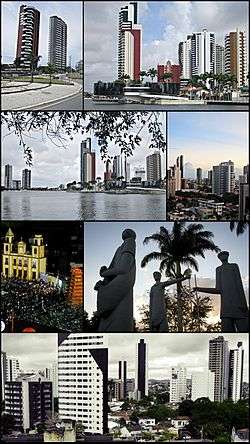 | |
 Flag  Seal | |
| Motto(s): Solum Inter Plurima | |
 Campina Grande Location in Brazil | |
| Coordinates: 7°13′50″S 35°52′52″W | |
| Country | |
| Region | Northeast |
| State | |
| Macroregion | Agreste Paraibano |
| Microregion | Campina Grande |
| Established | October 11, 1864 |
| Government | |
| • Mayor | Romero Rodrigues Veiga (PSDB) |
| Area | |
| • City | 620.628 km2 (239.626 sq mi) |
| Elevation | 560 m (1,840 ft) |
| Population (2017)[1] | |
| • Estimate (2017) | 410,332 |
| • Metro | 648,310 |
| Time zone | UTC-3 (BRT) |
| Postal Code | 58400-000 |
| Area code(s) | 083 |
| Website | www |
History
Origin
The founding of Campina Grande is credited to Captain Teodósio de Oliveira Ledo who led a group of Ariús Indians to settle the land and begin farming on December 1, 1697. However, some historians do not agree with this version and suggest that the place was already a settlement and named Campina Grande when Teodósio arrived with the Ariús. This position is certainly supported by the fact that Campina Grande is in a critical geographic location for people travelling between the highlands and the coast.
The political actions of Teodósio in mentioning Campina Grande to the king of Portugal in May 1699 went a long way to establishing the location as place of importance.
The Ariús inhabited a small farm made up of shacks which became the first street in the new community. Later, this street was called Rua do Oriente (Street of the East) and today it is known as rua Vila Nova da Rainha (New Village of the Queen). The Cathedral of Campina Grande was constructed on one of the higher slopes in the area. It formed the Matriz plaza which later also became one of city's most important streets: Avenida Marechal Floriano Peixoto.
The village soon became a town because of the commerce it attracted and the fact that there were few settlements in Paraíba.
Campina Grande began as a small village situated in front of an old lake called Açude Velho. These people were known as tropeiros because they were traveling merchants who traded and sold goods such as meat, cotton clothes and corn flour among the cities and villages they passed by. Campina Grande became the village (Vila Nova da Rainha) that they rested in as they were coming from the east to the coast.
The introduction of the railroad caused this tiny village to develop into a bustling city. At the beginning of the 20th century, Campina Grande was called "The Brazilian Liverpool" because of the numerous cotton plantations and factories. At the time, it was the second biggest producer in the world.
Today, the city has added to its old and rich traditions by becoming an oasis of high technologies in the middle of northeastern Brazil.
The town
Campina Grande reached the category of town in 1790 with more than 100 houses. On April 6, 1790 it changed its name to de Vila Nova da Rainha (New Village of the Queen). At this point the town also began to have a formal government made up of a town council and Notary's office.
Although the name of the town changed, the local inhabitants continued to call the place Campina Grande. However, in official documents the name, de Vila Nova da Rainha, was the only one used.
The town's development was spurred on by the growth of the regional cotton industry which preferred to ship its product through Campina Grande.

At this point the town included a large area of almost 900 square kilometres (350 square miles),including many smaller villages in the area.
The creation of the Village of Cabaceiras in 1835 and the Village of Alagoa Nova in 1850 reduced the area Campina Grande controlled.
In 1829, a dam across the Piabas stream was started and this became the lake referred to as Açude Velho. In 1852 the population of the town had reached 17,900 people, but in 1856, an epidemic killed almost 1,550 people. So many bodies arrived at the churches that they didn't have enough room to bury them.
The city

On October 11, 1864 Campina Grande was raised to the category of city. It was not the first to reach this designation though. In 1846, Areia had been designated a city and dominated the region economically, politically and culturally. Although Campina Grande was not as established as Areia, it was really not any smaller than that city. At this time, the city of Campina Grande had three plazas, four streets and about 300 houses. Of these, there still exist today the two churches: the Matriz (the Cathedral) and the Church of Our Lady of the Rosary. The latter had been destroyed at one time, but was rebuilt. Although there was plenty of commercial activity, there was very little actual construction of houses and government buildings. By the end of the nineteenth century, Campina Grande still only had about 500 houses.
In the year 1864 a building was constructed for the marketing of goods. This area had many names over time: "Largo do Comércio Novo", "Praça da Uruguaiana", "Praça das Gameleiras", "Praça da Independência" and finally, "Praça Epitácio Pessoa". In 1870 a law banning the washing of clothes and animals in Açude Velho was proclaimed. On September 18, 1865 the metric system was made the official form of measurement in Campina Grande.
In 1874, a rebellion led by João Vieira occurred. João Vieira and a number of revolutionaries came down from the Bodopitá mountain range and invaded the city's market. They broke into some money boxes and destroyed a few things. The revolt spread out across the region. Over time the rebels grew in numbers and became well armed. They were led by Manoel de Barros Souza and Alexandre de Viveiros. One of the objectives of Alexandre de Viveiros was to break into the city jail and liberate all the prisoners, including the father of Manoel de Barros Souza. They also planned to set the municipal offices on fire in order to destroy all the records kept there. However, over the next number of months the police force disrupted their plans. Alexandre de Viveiros was eventually imprisoned, but João Vieirad disappeared. After the revolt, the police abused the population without cause, arresting or punishing innocent citizens. Thus, the average person suffered both from the rebels and the police.
On March 25, 1877 a new Municipal building was constructed next to the Cathedral. It became one of the most elegant buildings in the state and initiated an area of fine homes.
In May 1891, a theatre was constructed for the purpose of both teaching and performance. This became the Colégio Alfredo Dantas.
The city continued to gradually develop, but economic and social changes really occurred only from the early 20th century. In this period, the railroad arrived and with it came cheaper and more varied products which impacted the local economy.
Technological centre
For a long time Campina Grande has had a strong technological focus. In 1967, the city was the first location in northeastern Brazil to receive a computer (at the Federal University of Campina Grande). Today, Campina Grande is a point of reference when it comes software development and computer science industries.
In April 2001, Newsweek magazine chose nine cities around the world that represented a new vision for technology. Brazil is represented on this list by Campina Grande and it was the only city chosen from Latin America. In 2003, it was mentioned again as the “Brazilian Silicon Valley,"
The reason for this success is mostly due to technological research performed by the Federal University of Campina Grande. Since 1967, when the university obtained support to buy its first computer for US$500,000, the city has developed a tradition of technological excellence that is recognized around the world.
Campina Grande has approximately 50 software companies that contribute about 20% of the city's total revenue.
Main sights
- Libraries
- Felix Araújo Municipal Library
- Açude Velho Public Library
- Campina Grande Public Library
- Cultural Centres
- Academia Campinense de Letras
- Museums
- Historical and Geographic museum of Campina Grande
- Assis Chateaubriand Museum of Art
- Museum of Cotton
- Museum of Luiz Gonzaga
- Museum of St. John
- Assis Chateaubriand Museum
- Home Marshal Anderson
- Squares and parks
- Flag Square
- Clementino Procópio Square
- Açude Novo (New Dam)
- Açude Velho (Old Dam)
- Bodocongó Dam
- Park of the People – Where the St. John's festival (O Maior São João do Mundo) is held
- Park of the Child
- Theatres
- Severino Bezerra Cabral Municipal Theatre
- Elba Ramalho Theatre
- Rosil Cavalcanti Theatre
- Facisa Theatre
- Raul Priston Theatre
- Ariano Suassuna Theatre
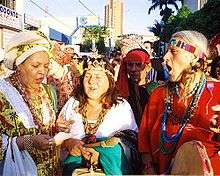
Culture
Events in Campina Grande include:
- Meeting for the Christian Conscience[2] (February, during Carnival)
- Meeting of the New Conscience (February, during Carnival)
- Vaquejada Park Ivandro Cunha Lima (March)
- Micarande (April)
- St. John's Festival (O Maior São João do Mundo, June)
- Campina Grande Winter Festival (August)
- Vaquejada Park Maria da Luz (October)
- Animal Exposition (October)
- Living Christmas Cradle (December)
- New Year's Eve on Açude Velho (December)
Public transportation
- Presidente João Suassuna Airport
- Argemiro de Figueiredo Bus Station – New
- Cristiano Lauritzen Bus Station – Old
Post-secondary education
- Federal University of Campina Grande – UFCG
- State University of Paraíba – UEPB
- Campina Grande Union of Secondary Education – UNESC (private)
- College of Applied Social Sciences – FACISA (private)
- Reinaldo Ramos Center of Secondary Education – CESREI (private)
- Acaraú Valley University – U.V.A. (private)
- English-American College (private)
Sports
Sport and recreation structures in Campina Grande include:
- Plínio Lemos Sports Complex
- The Meninão Gymnasium
- Amigão Stadium
- Renatão Stadium home stadium of the Campinense Clube
- President Vargas Stadium, home stadium of the Treze Futebol Clube
Local teams include:
- Campinense Clube
- Treze Futebol Clube
- Grêmio Serrano
- Associação Desportiva Perilima
- Associação Atlética Leonel
Neighborhoods
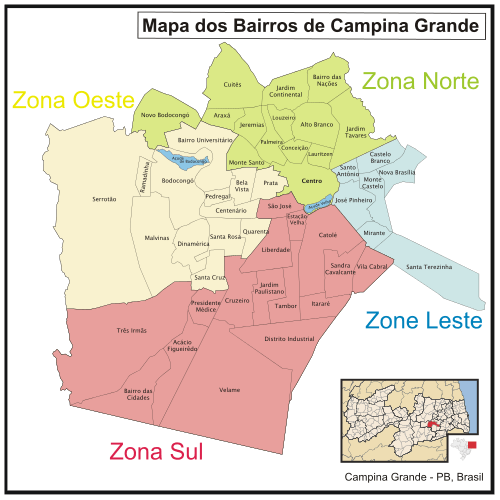
- Acácio Figueiredo
- Alto Branco
- Araxá
- Bairro das Cidades
- Bairros das Nações
- Bela Vista
- Bodocongó
- Cachoeira
- Araxá
- Castelo Branco
- Catolé
- Centenário
- Centro
- Conceição
- Cruzeiro
- Cuités
- Dinamérica
- Distrito Industrial
- Estação Velha
- Glória
- Itararé
- Jardim Borborema
- Jardim Continental
- Jardim Paulistano
- Jardim Tavares
- Jeremias
- José Pinheiro
- Lauritzen
- Liberdade
- Louzeiro
- Malvinas
- Mirante
- Monte Castelo
- Monte Santo
- Nova Brasília
- Novo Bodocongó
- Palmeira
- Pedregal
- Prata
- Presidente Médice
- Quarenta
- Ramadinha
- Sandra Cavalcante
- Santa Cruz
- Santa Rosa
- Santo Antônio
- São José
- Serrotão
- Tambor
- Três Irmãs
- Universitário
- Velame
- Vila Cabral
Economy
According to 1996 statistics from the Instituto de Pesquisa Econômica Aplicada, the Gross Internal Product was estimated at R$591.93 million: 3.3% came through agricultural and livestock based activities, 19.8% came through industry, and 76.9% was the result of the commerce and service sectors. The yield per capita was of R$1.717.09.
By 2002 the Brazilian Institute of Geography and Statistics estimated that the Gross Internal Product to have grown to R$1.600 billion and the yield per capita to R$4,387.00.
Local government
Campina Grande has 255,282 eligible voters distributed among 598 sections and four electoral districts.
The first election in 1878 had 34 eligible voters.
The office of Municipal mayor was created on March 2, 1895 by State Law. The first mayor of Campina Grande was Francisco Camilo of Araújo. People began to have the opportunity to vote for the mayor directly only from 1947.
Statistics
Education
| Schools | Students registered | Professors |
|---|---|---|
| Primary | 80,427 | 3,688 |
| Middle | 19,764 | 1,108 |
- Illiteracy rate: 17.12%.
HDI
| HDI | 1991 | 2000 |
|---|---|---|
| Value | 0.615 | 0.678 |
| Life expectancy | 0.585 | 0.641 |
| Education | 0.741 | 0.844 |
| Total | 0.647 | 0.721 |
Urban sanitation
| Service | Residences(%) |
|---|---|
| Water | 96.6% |
| Sanitary Sewers | 81.0% |
| Garbage Collection | 94.6% |
Health
- 2,634 hospital beds of which 2,148 are for free public health (2003, IBGE).
- Infant mortality: 76.6 persons/million (Ministry of Health/1998).
- Life expectancy: 63.5 years (IBGE, Census 2000).
Plant life
A list of 15 plants commonly found in the Campina Grande area. Of the 132 species of trees found, 51.2% originate from other countries and 32.8% are native species.
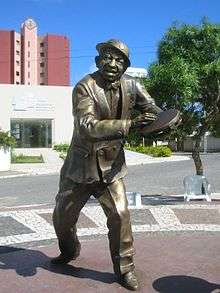
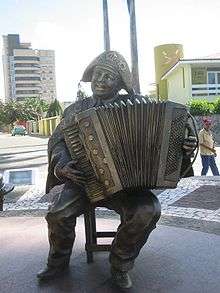
| Scientific Name | Popular Name |
|---|---|
| Senna siamea | Yellow Cássia |
| Prosopis juliflora DC | Algaroba |
| Clitoria fairchildiana Howard | Sombreiro |
| Terminalia catappa Linn | Castanet |
| Pithecellobium dulce | Hunger Killer |
| Pachira aquatica Aubl | Cocoa-bravo |
| Tabebuia chrysantha | Yellow Ipê |
| Delonix regia Raff | Flamboyant Tree |
| Licania tomentosa (Benth) Fritsch. | Oitizeiro |
| Ficus benjamina L | Benjamina Fig |
| Syzygium cumini DC. | Jambul |
| Roystonea oleracea Cook | Imperial Palm Tree |
| Schinus terebinthifolius Raddi | Aroeira-da-praia |
| Spathodea campanulata | Espatódia |
| Adenanthera pavonina L. | Brazil Cássia |
Climate
Campina Grande has a dry-summer tropical savanna climate (Köppen: As) that borders on a hot semi-arid climate (Köppen: BSh).
| Climate data for Campina Grande (1981–2010) | |||||||||||||
|---|---|---|---|---|---|---|---|---|---|---|---|---|---|
| Month | Jan | Feb | Mar | Apr | May | Jun | Jul | Aug | Sep | Oct | Nov | Dec | Year |
| Record high °C (°F) | 34.1 (93.4) |
34.2 (93.6) |
34.6 (94.3) |
33.2 (91.8) |
32.8 (91.0) |
31.9 (89.4) |
29.7 (85.5) |
29.7 (85.5) |
31.7 (89.1) |
33.5 (92.3) |
33.1 (91.6) |
33.8 (92.8) |
34.6 (94.3) |
| Average high °C (°F) | 30.7 (87.3) |
30.5 (86.9) |
30.1 (86.2) |
29.1 (84.4) |
27.7 (81.9) |
26.0 (78.8) |
25.6 (78.1) |
26.3 (79.3) |
28.0 (82.4) |
29.8 (85.6) |
30.5 (86.9) |
30.8 (87.4) |
28.8 (83.8) |
| Daily mean °C (°F) | 24.7 (76.5) |
24.7 (76.5) |
24.7 (76.5) |
24.3 (75.7) |
23.4 (74.1) |
22.1 (71.8) |
21.5 (70.7) |
21.5 (70.7) |
22.5 (72.5) |
23.5 (74.3) |
24.2 (75.6) |
24.5 (76.1) |
23.5 (74.3) |
| Average low °C (°F) | 21.2 (70.2) |
21.3 (70.3) |
21.4 (70.5) |
21.1 (70.0) |
20.5 (68.9) |
19.3 (66.7) |
18.6 (65.5) |
18.5 (65.3) |
19.0 (66.2) |
19.9 (67.8) |
20.4 (68.7) |
20.9 (69.6) |
20.2 (68.4) |
| Record low °C (°F) | 18.5 (65.3) |
19.1 (66.4) |
18.2 (64.8) |
18.7 (65.7) |
16.0 (60.8) |
16.2 (61.2) |
15.3 (59.5) |
15.3 (59.5) |
16.1 (61.0) |
17.3 (63.1) |
18.1 (64.6) |
17.7 (63.9) |
15.3 (59.5) |
| Average rainfall mm (inches) | 45.6 (1.80) |
62.8 (2.47) |
107.1 (4.22) |
89.3 (3.52) |
101.7 (4.00) |
123.6 (4.87) |
96.7 (3.81) |
80.1 (3.15) |
30.0 (1.18) |
12.5 (0.49) |
12.3 (0.48) |
15.3 (0.60) |
777 (30.59) |
| Average rainy days (≥ 1.0 mm) | 6 | 6 | 8 | 10 | 13 | 15 | 12 | 11 | 5 | 3 | 2 | 3 | 94 |
| Average relative humidity (%) | 74.3 | 75.0 | 77.4 | 79.2 | 81.6 | 84.0 | 82.9 | 80.3 | 74.7 | 71.3 | 71.0 | 72.0 | 77.0 |
| Mean monthly sunshine hours | 239.3 | 213.7 | 227.8 | 203.9 | 184.4 | 149.3 | 163.7 | 197.2 | 236.9 | 270.1 | 265.6 | 247.0 | 2,598.9 |
| Source: Instituto Nacional de Meteorologia[3] | |||||||||||||
Twin towns — sister cities
Campina Grande is twinned with:
Notable people
- Renan da Silva Costa, footballer
- Thaciano, footballer
- Aderbar Melo dos Santos Neto, footballer
References
- "". Instituto Brasileiro de Geografia e Estatística. Retrieved 30 August 2017.
- One of the largest conferences of Christian Apologetics in the world, which brings together more than 7,000 people every night for a week to discuss current issues from the Christian perspective: http://www.conscienciacrista.net/
- "Normais Climatológicas Do Brasil 1961–1990" (in Portuguese). Instituto Nacional de Meteorologia. Archived from the original on 22 September 2019. Retrieved 23 September 2019.